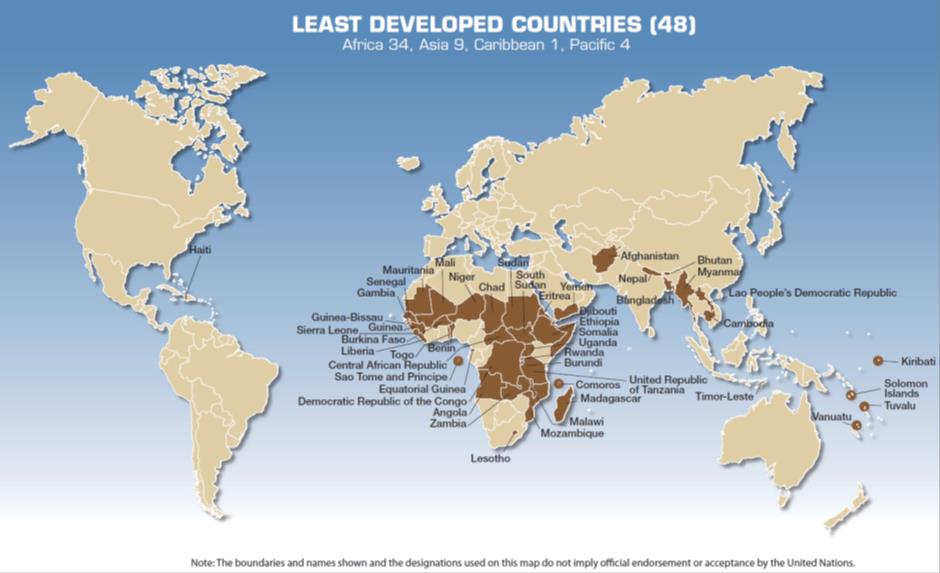Forty-eight countries currently are designated by the United Nations as "least developed countries" (LDCs), entitling a country to aid, preferential market access and special technical assistance, among other concessions. LDCs are distributed among the following regions:
Africa (34): Angola, Benin, Burkina Faso, Burundi, the Central African Republic, Chad, the Comoros, the Democratic Republic of the Congo, Djibouti, Equatorial Guinea, Eritrea, Ethiopia, the Gambia, Guinea, Guinea-Bissau, Lesotho, Liberia, Madagascar, Malawi, Mali, Mauritania, Mozambique, the Niger, Rwanda, Sao Tome and Principe, Senegal, Sierra Leone, Somalia, South Sudan, the Sudan, Togo, Uganda, the United Republic of Tanzania, and Zambia.
Asia (9): Afghanistan, Bangladesh, Bhutan, Cambodia, the Lao People´s Democratic Republic, Myanmar, Nepal, Timor-Leste, and Yemen.
Caribbean (1): Haiti.
Pacific (4): Kiribati, Solomon Islands, Tuvalu, and Vanuatu.
Since the category was defined forty years ago, four countries have graduated from LDC status: Botswana in December 1994; Cape Verde in December 2007; Maldives in January 2011; and Samoa in January 2014.
Establishing the LDC list and graduation from LDC status
The list of LDCs is reviewed every three years by the Economic and Social Council of the United Nations, based on recommendations by the Committee for Development Policy. The following three criteria were used by the Committee in the latest review of the list, in March 2012:
(a) Per capita income, based on a three-year average estimate of the gross national income per capita, with a threshold of $992 for possible cases of addition to the list, and a threshold of $1,190 for graduation from LDC status;
(b) Human assets, involving a composite index (the Human Assets Index) based on indicators of (i) nutrition (percentage of the population that is undernourished), (ii) health (child mortality rate), (iii) school enrolment (gross secondary school enrolment ratio) and (iv) literacy (adult literacy rate);
(c) Economic vulnerability, involving a composite index (the Economic Vulnerability Index) based on indicators of (i) natural shocks (index of instability of agricultural production, and share of the population that has been victimized by natural disasters), (ii) trade-related shocks (index of instability of exports of goods and services), (iii) physical exposure to shocks (share of the population living in low-lying areas), (iv) economic exposure to shocks (share of agriculture, forestry, and fisheries in gross domestic product, and index of merchandise export concentration), (v) smallness (population in logarithm), and (vi) remoteness (index of remoteness).
For all three criteria, different thresholds are used for identifying cases of addition to and graduation from the ranks of LDCs.
A country will qualify to be added to the list if it meets the addition thresholds on all three criteria and does not have a population greater than 75 million.
Qualification for addition to the list will effectively lead to LDC status only if the Government of the relevant country agrees to accept this status.
A country will normally qualify for graduation from LDC status if it has met the graduation thresholds of at least two of the three criteria during the period covered by at least two consecutive triennial reviews of the list.
However, if the per capita gross national income of an LDC has risen to a level at least double the graduation threshold, the country will be deemed eligible for graduation regardless of its performance under the other two criteria.

Full report: http://unctad.org/en/PublicationsLibrary/ldc2014_en.pdf
Overview: http://unctad.org/en/PublicationsLibrary/ldc2014overview_en.pdf


